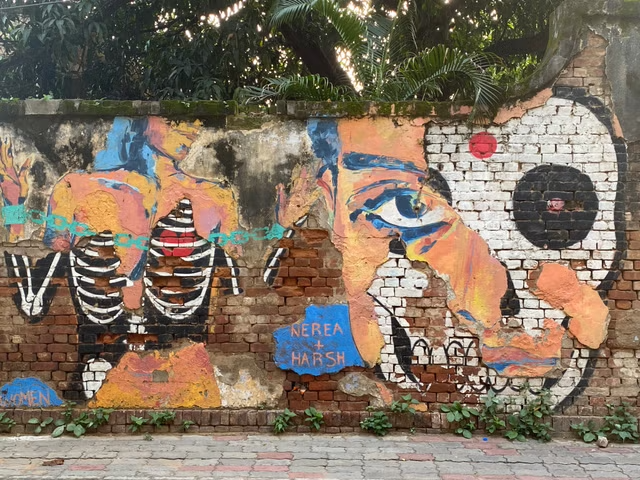Introduction
Delhi’s painted public service messages are a unique and captivating facet of the city’s culture. These artworks, which often convey important messages on issues like hand-washing and safe sex, grace the walls of the city, created by skilled sign painters. Delhi’s street art scene, unlike many other places, maintains a strong connection with government institutions, leading to an exciting fusion of art and civic engagement. In this article, we delve into the fascinating world of street art in Delhi, exploring how collaborations with government bodies have given artists a platform to showcase their talent.
Artistry Behind Bars: Tihar Jail’s 968-Meter Mural
Tihar Jail, one of India’s largest prisons, might seem like an unlikely canvas for art. However, St+art, a Delhi-based not-for-profit street art organisation, joined forces with prison authorities to create India’s longest mural. Stretching an impressive 968 meters, this mural featured lines from a poem that poignantly referenced the inmates’ feelings of isolation. Inmates participated in workshops led by street artists, leading to their own mural creations within the prison’s walls.

Mahatma Gandhi’s Towering Presence
Delhi proudly boasts India’s tallest mural, a towering 45-meter-high image of Mahatma Gandhi adorning one side of New Delhi’s Police Headquarters. This remarkable artwork is the result of a collaboration between street artists connected to St+art, including German street artist Hendrick ECB and Indian street artist Anpu Varkey. Unveiled on Martyr’s Day in 2022, this mural pays homage to the national hero and sparked conversations about the fusion of street art and government institutions. It represents a potential shift in how people perceive and engage with art in public spaces.
From Cat to Landmark: Shahpur Jat’s Transformation
Shahpur Jat, a colourful neighbourhood in Delhi, saw its transformation into a hub for street art, and it all began with a supersized cat painted by Anpu Varkey. This whimsical mural, initially mistaken for an advertisement due to its unusual subject, soon became a landmark for the area. The neighbourhood, affectionately known as “Billi” (the Hindi word for cat), has evolved into one of Delhi’s top destinations for street artists. Its streets are now adorned with numerous murals, each telling a unique story and adding to the area’s vibrant character.
Street Art as a Rite of Passage
Delhi’s street art scene has seen a growing influx of international talent, such as Bond Truluv, a German artist who has had a significant impact on the community. His diverse and distinctive works have inspired local artists to approach their craft with a fresh perspective. Street art in Delhi is no longer just a hobby; it has become a viable career option. Young artists receive commercial commissions for restaurants and other projects, demonstrating the industry’s growth and potential for future generations.
Lodhi: Delhi’s First Street Art District
Lodhi, often referred to as Delhi’s first street art district, has undergone a remarkable transformation. Abandoned buildings, wrapped in triffid-like greenery, now serve as canvases for colorful murals. These collaborations between St+art and local authorities showcase how street art can breathe life into entire areas. Initially, there were restrictions on painting above certain arches, but the artists’ determination to push boundaries led to a change in the authorities’ perspective.

Agrasen Ki Baoli and Beyond
In the heart of Delhi, the 14th-century Agrasen Ki Baoli stepwell reveals a newfound transformation, thanks to local street artists. Alongside government-commissioned art, freshly spray-painted murals by Indian street artists now adorn the streets. The influence of other street art scenes is evident, alongside a strong local identity. Notably, a mural featuring the tail feathers of a peacock, India’s national bird, has become a sought-after spot for tourists and photographers. It’s a symbol of the dynamic fusion of tradition and transformation that defines Delhi’s street art scene, and a tribute to icons like Mahatma Gandhi, whose legacy lives on through art.
Conclusion
Delhi’s street art scene signifies the collaboration between artists and government institutions. From prisons to police headquarters and historic neighbourhoods, murals in the city have transformed public spaces into vibrant canvases. These artworks have the potential to spark conversations, change perceptions, and provide opportunities for emerging artists. In Delhi, street art is more than just paint on walls; it’s a dynamic force that fuses tradition with transformation, and it shows no signs of slowing down.
Feature Image Courtesy: Tamara Hinson

Contributor





